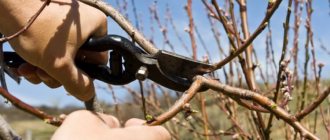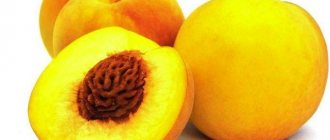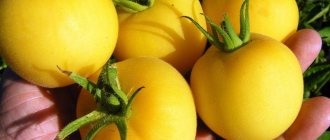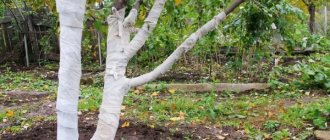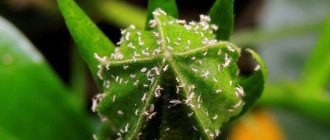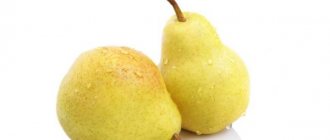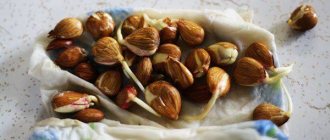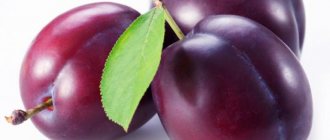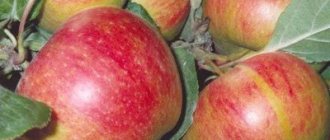- 4.1 Site selection and soil preparation
- 5.1 How to trim a columnar peach
Columnar peach is a relatively new type of fruit tree, widely used both for decorative purposes and for harvesting. The use of columnar trees can significantly save garden space. Caring for such plants is quite simple and allows even novice gardeners to grow them.
Benefits of growing columnar peaches
Compared to regular columnar peaches, they have quite a few advantages. These include:
- Small in size, which allows you to place quite a lot of different varieties in a small area.
- Convenience of care and harvesting.
- Resistance to diseases and pests.
- Early onset of fruiting.
- Good fruit taste.
- The fruit size is larger than usual.
- The crown requires almost no pruning.
- High winter hardiness.
Despite the fact that reviews of columnar peaches are very good, they are not without their drawbacks. Such trees do not have high yields due to their small size. Their lifespan is much shorter than usual.
Columnar peaches have another drawback - the high price of seedlings, reaching up to 1000 rubles per 1 piece.
General description of columnar peaches The columnar peach got its name for the characteristic shape of the crown, reminiscent of a column. It is a low deciduous fruit tree. Its height is usually no more than one and a half meters, although there are varieties with a higher crown. Columnar peach is planted singly or in group plantings for decorative purposes. The plants look very impressive both during flowering and during fruiting.
How can you check a seedling when purchasing to avoid misgrading?
The purchase of a columnar seedling should be taken seriously. Firstly, its cost is higher than usual, and secondly, extra time will pass until you realize that you did not buy what you wanted.
It is recommended to purchase columnar peaches and nectarines only from trusted nurseries that specialize in growing such crops. We generally do not recommend buying seedlings from markets and retail stores, since in this case no one is responsible for their quality and the authenticity of the variety.
When choosing a tree for planting, you should pay attention to the fact that the seedling is 1 year old. These take root more easily and begin to bear fruit the next year after planting.
The top bud should be alive and green in color. The seedling should not have leaves. The roots should be inspected and attention should be paid to their elasticity and the absence of dry branches.
If seedlings are purchased in advance, the roots are wrapped in soft cloth and kept moist, periodically moistened with water. It is recommended to keep the seedling in a dry and dark place.
Characteristics of columnar varieties of peaches
Columnar varieties of peaches have increased resistance to pests and diseases compared to ordinary trees. Due to their small size, their yield is much lower, but the fruits themselves are larger and tastier. They are more winter-hardy than ordinary ones and can easily withstand temperatures down to -40°C.
In terms of flowering and fruiting times, trees of this type do not differ from ordinary peaches; among them there are both early and late varieties.
Features of planting columnar peach
The ideal rootstock for columnar peach is any dwarf variety of this crop. Ukrainian gardeners working in this area suggest using Manchurian peach for such purposes - one of the best rootstocks in terms of compatibility with the scion and winter hardiness.
This plant form was selected in Poland from peach seedlings brought from Manchuria. The growth of Manchurian peach trees on this seedling rootstock ranges from semi-dwarf to medium-sized, depending on the vigor of the grafted variety. It is important that the varieties grafted onto these seedlings not only have no tendency to shred, but also produce larger fruits compared to other known rootstocks.
https://www.agrocounsel.ru/manchzhurskij-persik-podvoj
This is what a two-year-old Manchurian peach looks like
To plant columnar peach, no special skills are required. It is best to place such trees on the south or south-east side of the site on loose, fertile soil - chernozem or sandy with an admixture of humus. Gardeners often plant peaches along walls or fences in a part of the garden where there is enough light and no drafts.
It is recommended to start planting columnar peaches in the spring - from the end of March (in the southern regions) to the first days of May (in areas with a harsh climate). Columnar peaches with a closed root system can be purchased for planting until the 2nd–3rd decade of May. Landing rules:
- Peaches with a crown in the form of a column are placed at a distance of 0.6 m from each other, keeping the space between the rows for group planting - 1–1.2 m, dig a planting hole with a diameter of 0.5 m, a depth of 0.6–0.7 m .
- A drainage layer is laid at the bottom - crushed brick, medium-sized gravel, expanded clay (layer 8–10 cm). Then pour a layer of fertile soil (equal parts sand, humus, chernozem, garden soil) - 10–15 cm.
- If you spill the hole, half a bucket of water is enough.
- The peach is carefully placed vertically in the hole, sprinkled with soil, and lightly compacted on top - this is necessary for the stability of the young tree; You can immediately place a wooden peg on it as a support, this is temporary - as soon as the peach takes root, the support is removed.
When planting a columnar peach, the root space is compacted
Video: planting columnar peach
Popular varieties of columnar peach
Gardener's totem. It is one of the most popular varieties of columnar peach. This is a medium-early ripening variety; the fruits usually reach maturity in the second half of July. The height of the tree does not exceed 1.7 m. The fruits are large, weighing up to 300 g, round. The pulp is juicy, yellow-orange in color, and has a sweet taste. Ripe fruits have a good presentation, high transportability, and are well stored. The total yield can reach 12-14 kg per tree. The gardener's totem is one of the most unpretentious varieties, not demanding on growing conditions.
Steinberg. The variety is distinguished by a pyramidal crown shape. The height of an adult tree can reach 2 meters. The fruits are round, orange-yellow in color. Their average weight is 150 g. On the sunny side, a crimson blush appears on the peaches. The pulp is aromatic, juicy yellowish in color.
Anniversary of the capital. A tree of this variety grows up to one and a half meters. Its fruits are bright yellow, weigh 230–250 g, and have a sweet taste. They can be used both for fresh consumption and for canning.
Golden Triumph. An early ripening variety, ripening in early July. The average height of the tree is up to one and a half meters. The crown is compact. The fruits are red, the flesh is orange, sweet, aromatic. The average fruit weight is 250–280 g. The total yield can reach 10 kg per tree. The variety is highly resistant to diseases, as well as increased frost resistance.
Honey. This is an early variety, ripening in early July. The crown is medium in size, the height of the tree can reach 2 meters. Fruits up to 200 g, round in shape, yellow with a characteristic blush, slightly pubescent. The taste is sweet.
Souvenir. Crimean variety of columnar peach. The tree can reach 2.5 m in height, with a crown up to half a meter in diameter. The fruits ripen quite late, in the first half of August. They are yellow in color, with a slight blush and slight pubescence. The pulp is yellow, juicy, sweet.
Varieties of columnar peaches for the Moscow region
The climate of the Moscow region is by no means ideal for such a southern crop as the peach. However, the high frost resistance and disease resistance of these trees makes their cultivation possible even in such conditions. Now columnar peaches grow well not only in the Moscow region, but also in more northern territories.
All the varieties described above have high winter hardiness, so they can easily withstand winters near Moscow. In addition, you can try to grow the columnar Fig peach in the Moscow region. This is a relatively young variety. The height of the tree does not exceed 2 m. The fruits are flattened, sweet and juicy, but lie and are poorly transported due to their delicate skin. Their weight is 150–180 g.
Important! Peaches of this variety can be grown in pots.
Pros and cons of varieties
Varieties of columnar peaches have the following positive qualities:
- the ability to plant in small areas due to its compactness;
- high productivity, since in the first years up to 7 kg of fruit can be collected from a tree;
- the weight of each fruit is 200-225 g;
- easy to maintain and no need for pruning;
- excellent taste;
- frost resistance and resistance to temperature changes.
In winter, the tree can withstand a temperature drop of up to -30 degrees. The disadvantages of plantings include a short fruiting period. The tree dies early, so it is necessary to renew the plantings on the site more often.
Important!
Due to their high characteristics, seedlings have a high cost. This is another disadvantage of columnar plantings.
Planting and caring for columnar peaches
For planting, annual seedlings of columnar peach are usually used. When choosing them, you should be especially careful, taking into account their cost. The seedling must look good and have a developed root system. Columnar peach is planted in late autumn or early spring, before the beginning of the growing season.
Site selection and soil preparation
For good growth and development of the plant, a large amount of sunlight is necessary, so it is advisable to choose a place on the south side of the site. It is not recommended to plant it in the shade of other trees, buildings and structures. Wetlands and low-lying areas, as well as areas with high groundwater levels, are not suitable for planting.
Preparing the soil for planting should be done in advance. The place for the future seedling is cleared, removing weeds and excess debris. After this, the area is dug up and humus or rotted manure is added to the soil. It is best to do this in the fall if planting is planned in the spring. When planting in autumn, the procedure should be carried out at least a month before the planned planting date.
Landing algorithm
Planting holes for planting columnar peach are dug taking into account the size of the root system of the seedling. Usually this is a hole with a diameter of about half a meter and a depth of 50-60 cm. A drainage layer of broken brick, crushed stone or expanded clay in a layer of 7-10 cm is laid on the bottom, then the same layer of fertile soil is poured. Near the center of the hole you need to drive a peg to which the young tree will be tied.
The seedling is placed vertically in the hole and carefully covered with soil. It must be lightly compacted to prevent voids from forming in the ground. Then the tree trunk circle needs to be watered generously. The planted tree must be tied to a support, this will protect it from damage by the wind.
What is a columnar peach?
Column peach is an ornamental tree that fits perfectly into the landscape of any garden, produces a good harvest and does not require much attention - these bonuses primarily attract gardeners. Well, gardening luminaries need such a culture for the sake of exoticism and diversity. In fact, the columnar peach is a short tree - no more than 1.4–1.6 m, forming a crown in the form of a cylinder or column.
But there is one thing: columnar fruit trees are currently officially represented only in one crop - the apple tree, as experts in this field say with full responsibility. The apple tree forms a column due to its small branching; the fruits on columnar apple trees are set directly on the trunk.
In 1964, an apple tree was found in Canada without side branches, but with more fruits directly on the trunk. This feature of apple tree development was attributed to a mutation and attempts were made to propagate it, apparently quite successfully. And as before, this type of fruit formation occurs only on apple trees; the “trick” does not work with other fruit trees - already in the 3rd–4th year, seedlings with fruits on the trunks, if this is still achieved, turn into ordinary trees, the height of which exceeds 2 m, and fruit formation occurs only on well-developed long shoots of the second year. Even if it is possible to create a semblance of a “column” on a peach, plum, or cherry, it is only due to shortening the fruiting shoots. This achieves the effect of fruiting on the trunk - visual columnarity.
Video: the whole truth about the columnar peach
Columnar varieties of fruit trees are represented by low-growing cultivars, but they bear fruit abundantly - if we take into account the total area of fruiting shoots, then 4–6 kg from one columnar tree will be quite a decent harvest. Plants with this type of crown are assessed primarily according to the following parameters:
- trees take up little space - comparable to a two-year-old seedling of any garden crop;
- high winter hardiness, besides, dwarf trees in the form of a column are easy to cover, so they are often recommended for forcing in harsh climates;
- good survival rate of heat-loving crops;
- excellent taste of fruits and large-fruited size - for columnar varieties of peaches it is not uncommon for the fruit to weigh up to 200 g or more, and harvesting is not at all difficult - aromatic fruits are at most at arm's length;
- easy pruning;
- a tree needs only 10–15 liters of water per single watering, while a tall peach at the time of fruiting requires at least 3–5 buckets of water (30–50 liters); feeding and loosening the soil for a columnar peach is also easier - the trunk circle and radius the trunk is smaller than that of ordinary peach trees;
- processing of columnar peaches is also simplified - a 1.5-meter tree is much easier to spray than a giant 2-3 meters high.
What pitfalls await farmers who decide to grow columnar peaches:
- in comparison with classic peach varieties, columnar peach has a low yield due to the small size of the tree;
- short life span - 5–7 years;
- high price of seedlings.
But other shortcomings of this type of crop cannot be ruled out, the most obvious being that not a single amateur gardener has yet provided evidence of the stunning results of growing columnar peaches in practice for a long time. So far, you can only find offers in online stores to buy seedlings of such peach. But there are also no details on caring for such a tree, trends in fruiting over the next 3-5 years after planting, or evidence of the annual high yield of columnar peaches without effort.
It’s almost impossible to find real photos of columnar peaches with fruits, but there is a lot of Photoshop on the Internet - a reason to think about the truth about columnar peaches
It is believed that dwarf varieties of fruit trees were created for forcing in intensive gardens, where seedlings are replaced every 5–7 years. And columnarity, in particular on an apple tree, is achieved by purity, when, as a result of vegetative crossing, the internodes on the shoots are shortened. Sometimes the fruit buds are so close that when the crop ripens, a crowding effect is created - the fruits are located densely, as if along the trunk - on a low-growing tree with short pruning we see the effect of the fertility of a columnar crop.
Growing columnar peaches is not the best idea for those who want a high yield from the peach and are not inclined to plant new trees in the garden every 4-5 years. Moreover, most often it is a deception of Internet scammers, an outrage on the imagination of inexperienced gardeners. I agree that a columnar orchard from the “climbing strawberry” series can be planted, but the result is unpredictable - it is hardly possible to get a decent harvest from one peach tree trunk. But it’s easy to grow such a tree as an exotic tub crop to the surprise of guests and to admire the enchanting flowering of pink peach buds. I would rather classify the columnar peach not as a fruit tree, but as an ornamental shrub. And striving for high yields of columnar peaches is like trying to pick 3 buckets of barberries from a bush.
Read also: Which heater can heat a room faster?
Caring for Columnar Peaches
Further care for columnar peaches is not particularly difficult. Throughout the year, it is treated to protect it from diseases and pests, watered, fertilized, loosened and mulched. The frequency of watering depends on the amount of precipitation. In dry weather, trees are watered approximately once a week. If there is enough precipitation, watering can be done once a month or less. The tree needs to be fed several times a season. As a rule, complex mineral fertilizers are used for this in spring and summer, and organic matter in autumn.
During the season, wood is treated 2-3 times with special preparations to prevent diseases. Despite the fact that the columnar peach is a fairly frost-resistant plant, it must be covered for the winter. To do this, you can use various materials that allow air to pass through: burlap, paper, parchment, straw, dry reeds and others.
Important! You cannot use plastic film, which does not allow air to pass through, for winter shelter.
How to trim a columnar peach
Pruning of columnar peach is done in early spring, before the beginning of the growing season. At this time, old, diseased, dry branches are removed, and the annual growth is also shortened to a length of 15-20 cm. This will allow the tree to maintain its decorative appearance. In the fall, a preventive inspection of the peach is carried out, during which damaged and dry branches are also removed.
A video about pruning columnar peach and other columnar trees can be viewed at the link below.
Characteristics of the variety
This variety got its name because the crown of its tree resembles a column in shape. Each tree reaches only a meter and a half in height. They do not take up much space in the garden and benefit it with their decorative appearance.
The crowns of columnar peaches are simple and uncomplicated. The trunk has lateral branches with leaves that lack branches. It looks very unusual and charming. It feels like the large fruits are stuck to the stem itself.
How to care for columnar peaches
In the future, caring for the peach will not be difficult - the tree is watered, fed, treated against diseases and pests, the tree trunk is periodically loosened and weeds are removed:
- the frequency of watering depends on the amount of precipitation during the growing season, but at least once every 10 days (1-2 buckets of water), with heavy rainfall - 1-2 times a month;
- It is recommended to carry out disease and pest prevention at least 3-4 times a season: treatment with special preparations (Chorus, Skor and others) is organized by:
- at the end of March - April;
- in early May before flowering;
- immediately after fruiting;
- in early September;
- columnar peach is responsive to feeding:
- in the spring, nitrogen-phosphorus fertilizers are applied (for example, 1 tablespoon of superphosphate per bucket of water, after the procedure the tree is watered abundantly);
- in early June - potassium-phosphorus complex preparations (according to instructions);
- at the end of summer, peaches are fed with organic matter - for example, an infusion of humus (1 teaspoon of humus, 2 teaspoons of water) - take 1/3 of a bucket of fertilizer and dilute it to a full bucket with water (for one tree).
Column peaches lose their flowers the first year they are planted. Only the next year (the 3rd year of growth or the 2nd year after planting the seedling from the nursery) are flowers left. During the first fruiting you can get 3–10 fruits, the next year the harvest can be 2 times more.
Video: formation of the crown of columnar fruit trees, including peach
An ideal columnar peach is driven into one trunk without additional shoots, the branches are cut to 4–7 cm, thus obtaining a columnar peach. If the trunk is not formed, the side shoots will grow and the tree will not be columnar; a bush or cup-shaped crown will form.
For the winter, gardeners advise insulating columnar peaches . To do this, after dropping the leaves (late October - early November), the tree is carefully, without damaging the buds, wrapped with non-woven material or improvised means (as in the video below it is suggested to cover such a peach with dry corn stalks).
Read also: How often to water tomatoes in open ground
Video: sheltering a columnar peach for the winter
Having scoured the Internet, I can say: columnar peach does not require much attention and produces a good harvest. But it is stupid to compare it with classic types of peach - traditional trees bear fruit more abundantly and for many years, and columnar trees - 2-3 years. Even if you plant 10 columnar peach trees in the same space that a peach with a regular crown can occupy, their yield will be lower. Columnar peaches are a crop for intensive gardening; a decent harvest according to the varietal characteristics can be obtained for several years; 6 years after planting they lose their effectiveness. It is not difficult to care for them, but you need to water them more often; in the event of a fungal disease or pests (despite the promised high immunity, no one is 100% insured), the entire tree will most likely die. Therefore, when purchasing a columnar peach, it is necessary to calculate the efficiency of cultivation and costs in advance.
